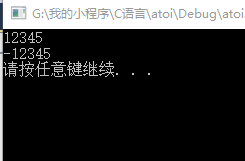C语言模拟实现atoi函数的实例详解 atoi函数,主要功能是将一个字符串转变为整数,例如将“12345”–12345。但在实现过程中,我们难免会因为考虑不够全面而漏掉比较重要的几点,今天
C语言模拟实现atoi函数的实例详解
atoi函数,主要功能是将一个字符串转变为整数,例如将“12345”–>12345。但在实现过程中,我们难免会因为考虑不够全面而漏掉比较重要的几点,今天就总结一下实现atoi函数需要注意的地方。
1.指针为NULL
2.字符串为空字符串
3.空白字符
4.正号与负号问题
5.溢出问题
6.异常字符处理
接下来看代码:(具体几种问题处理都在代码的注释中说明)
#define _CRT_SECURE_NO_WARNINGS 1
#include <stdio.h>
#include <stdlib.h>
#include <ctype.h>
#include <assert.h>
//定义两个枚举常量来表示状态
enum STATE
{
VALID, //合法
INVALID,//非法
};
enum STATE state = INVALID;
int my_atoi(const char *str)
{
int flag = 1;
long long ret = 0;//定义为比int存储范围还要大的类型,防止后面判断溢出时出错。
//空指针
assert(str);
//空字符串
if (*str == "\0")
{
return 0;
}
//空白字符
while (isspace(*str))//用函数isspace判断是否为空白字符
{
str++;
}
//遇到正负号
if (*str == '-')
{
flag = -1;
str++;
}
if (*str == '+')
{
str++;
}
//
while (*str)
{
//if (*str >= '0'&&*str <= '9')
if (isdigit(*str))//用函数isdigit判断是否为数字字符
{
ret = ret * 10 + flag*(*str - '0');
//判断是否溢出
if (ret > INT_MAX || ret < INT_MIN)
{
return ret;
}
}
//异常字符
else
{
break;
}
str++;
}
state = VALID;
return ret;
}
int main()
{
char *p = "12345";
char *q = " -12345";
int ret = my_atoi(p);
int ret2 = my_atoi(q);
printf("%d\n", ret);
printf("%d\n", ret2);
system("pause");
return 0;
}
运行结果:

以上就是C语言模拟实现atoi函数的实例,如有疑问请留言或者到本站社区交流讨论,感谢阅读,希望能帮助到大家,谢谢大家对本站的支持!
